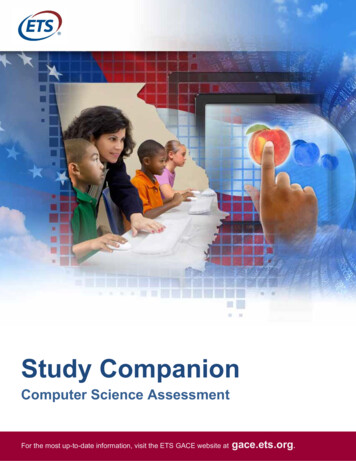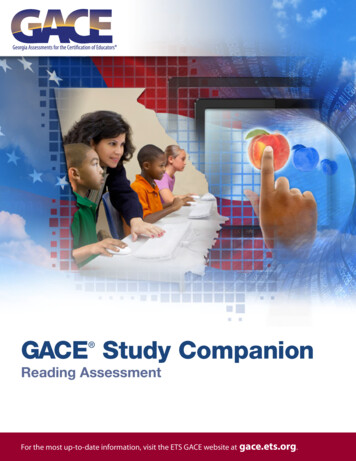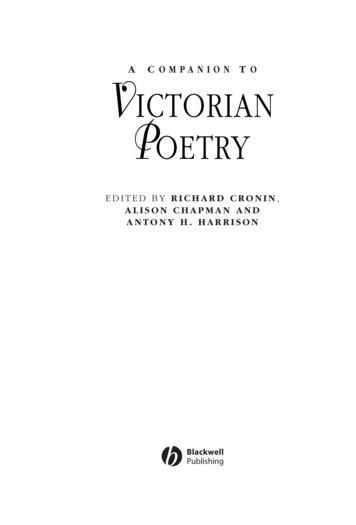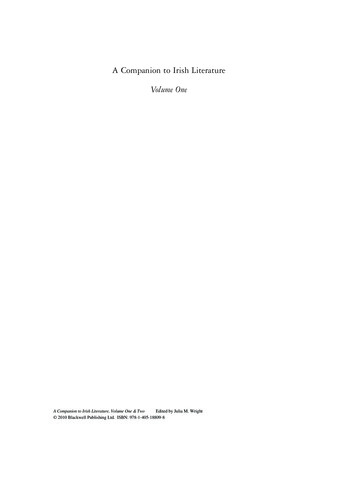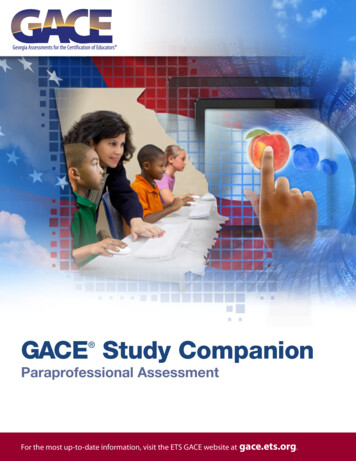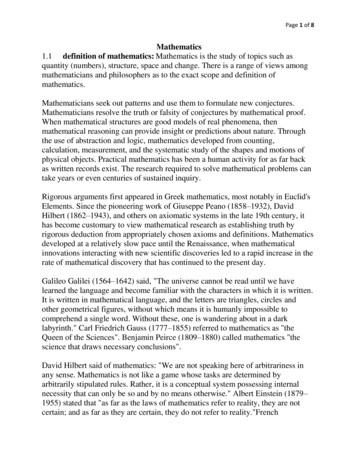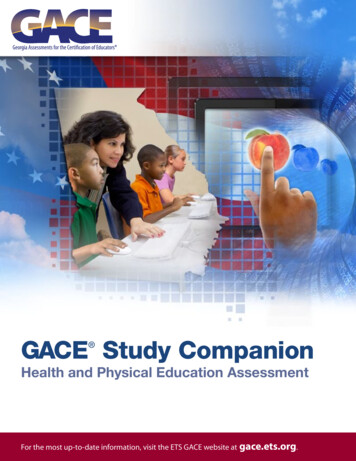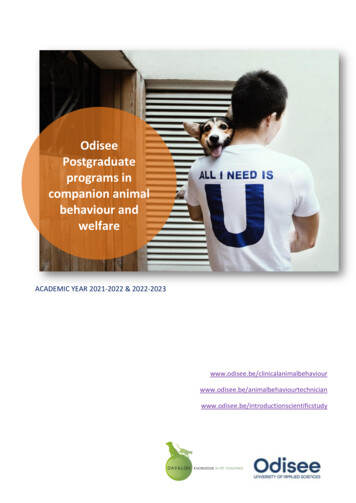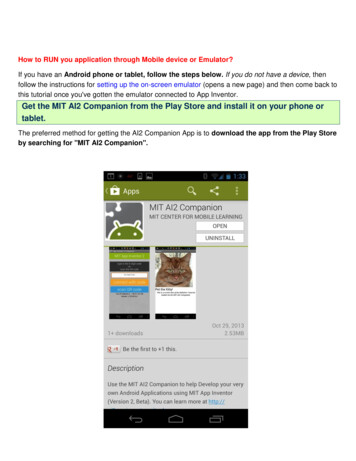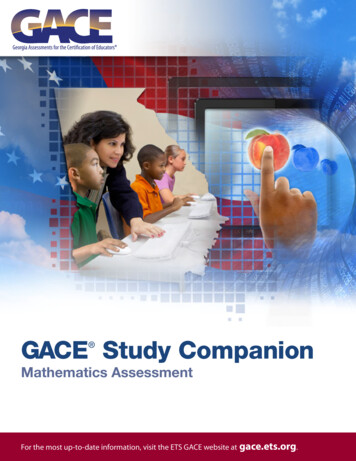
Transcription
GACE Study Companion Mathematics AssessmentFor the most up-to-date information, visit the ETS GACE website at gace.ets.org.
Last Updated: February 2022Copyright 2022 by Educational Testing Service. All rights reserved. ETS is a registeredtrademark of Educational Testing Service (ETS). Georgia Assessments for the Certification ofEducators, GACE, and the GACE logo are registered trademarks of the Georgia ProfessionalStandards Commission (GaPSC). All other trademarks are property of their respective owners.This publication has been produced for the GaPSC by ETS. ETS is under contract to theGaPSC to administer the Georgia Assessments for the Certification of Educators. TheGeorgia Assessments for the Certification of Educators are administered under the authorityof the GaPSC; regulations and standards governing the program are subject to change withoutnotice at the discretion of the GaPSC. The GaPSC and ETS are committed to preventingdiscrimination on the basis of race, color, national origin, sex, religion, age, or disability in theadministration of the testing program or the provision of related services.
Table of ContentsTable of Contents . 3About the Assessment . 4Content Specifications . 5Test I Subareas. 6Test I Objectives . 6Subarea I: Number and Quantity . 6Subarea II: Algebra. 9Subarea III: Discrete Mathematics and Calculus . 11Test II Subareas . 15Test II Objectives . 15Subarea I: Functions . 15Subarea II: Geometry . 18Subarea III: Probability and Statistics . 21Practice Questions . 24Answer Key and Rationales . 49Preparation Resources . 75Calculator Use . 75Guide to Taking a GACE Computer-delivered Assessment . 75Reducing Test Anxiety . 75Study Tips: Preparing for a GACE Assessment . 75Journals. 75Other Resources . 75Online Resources . 77GACE Mathematics Assessment Study Companion3
About the AssessmentAssessment NameMathematicsGrade Level6–12Test CodeTest I: 022Test II: 023Combined Test I and Test II: 522Testing TimeTest I: 2 hours 15 minutesTest II: 2 hours 15 minutesCombined Test I and Test II: 4.5 hoursTest DurationTest I: 2 hours 30 minutesTest II: 2 hours 30 minutesCombined Test I and Test II: 5 hoursTest FormatComputer deliveredNumber of Selected-response QuestionsTest I: 50Test II: 50Combined Test I and Test II: 100Question FormatThe test consists of a variety of short-answerquestions such as selected-responsequestions, where you select one answerchoice or multiple answer choices (dependingon what the question asks for), questionswhere you enter your answer in a text box,and other types of questions. You can reviewthe possible question types in the Guide toTaking a GACE Computer-delivered Test.Number of Constructed-response QuestionsTest I: 0Test II: 0Combined Test I and Test II: 0The GACE Mathematics assessment is designed to measure the professional knowledge ofprospective teachers of 6–12 mathematics in the state of Georgia.This assessment includes two tests. You may take either test individually or the full assessmentin a single session. The testing time is the amount of time you will have to answer the questionson the test. Test duration includes time for tutorials and directional screens that may be includedin the test.GACE Mathematics Assessment Study Companion4
The questions in this assessment assess both basic knowledge across content areas and theability to apply principles.The total number of questions that are scored is typically smaller than the total number ofquestions on the test. Most tests that contain selected-response questions also includeembedded pretest questions, which are not used in calculating your score. By including pretestquestions in the assessment, ETS is able to analyze actual test-taker performance on proposednew questions and determine whether they should be included in future versions of the test.Content SpecificationsEach test in this assessment is organized into content subareas. Each subarea is furtherdefined by a set of objectives and their knowledge statements. The objectives broadly define what an entry-level educator in this field in Georgia publicschools should know and be able to do. The knowledge statements describe in greater detail the knowledge and skills eligible fortesting. Some tests also include content material at the evidence level. This content serves asdescriptors of what each knowledge statement encompasses.See a breakdown of the subareas and objectives for the tests in this assessment on thefollowing pages.GACE Mathematics Assessment Study Companion5
Test I SubareasSubareaApprox. Percentageof TestI. Number and Quantity30%II. Algebra40%III. Discrete Mathematics and Calculus30%Test I ObjectivesSubarea I: Number and QuantityObjective 1: Understands and applies knowledge of the real number system and vector andmatrix quantitiesThe beginning Mathematics teacher:A. Understands the properties of exponents Performs operations involving exponents, including negative and rationalexponents Demonstrates an understanding of the properties of exponential expressions Uses the properties of exponents to rewrite expressions that have radicals orrational exponentsB. Understands the properties of rational and irrational numbers and the interactionsbetween those sets of numbers Recognizes that the sum or product of two rational numbers is rational Recognizes that the sum of a rational number and an irrational number isirrational Recognizes that the product of a nonzero rational number and an irrationalnumber is irrational Recognizes that the sum or product of two irrational numbers can be rationalor irrationalC. Is familiar with the representation and modeling of vector quantities and how operationson vectors are performed Represents vector quantities by directed line segments and uses appropriatesymbols for vectors and their magnitudes Finds the components of a vector by subtracting the coordinates of an initial pointfrom the coordinates of a terminal point Solves problems involving velocity and other quantities that can be representedby vectorsGACE Mathematics Assessment Study Companion6
Adds vectors end-to-end, component-wise, and by the parallelogram rule Given two vectors in magnitude and direction form, determines the magnitudeand direction of their sumD. Understands how to perform operations on matrices and how to use matricesin applications Uses matrices to represent and manipulate data Multiplies matrices by scalars to produce new matrices Adds, subtracts, and multiplies matrices of appropriate dimensions Understands that matrix multiplication for square matrices is not a commutativeoperation but still satisfies the associative and distributive properties Understands the role played by zero and identity matrices in matrix addition andmultiplication Understands that the determinant of a square matrix is nonzero if and only if thematrix has a multiplicative inverseE. Understands how to solve problems involving ratios, proportions, averages, percents,and metric and traditional unit conversions Applies the concept of a ratio and uses ratio language and notation to describe arelationship between two quantities and solve problems Uses ratio reasoning to convert rates Solves problems involving scale factors Recognizes and represents proportional and inversely proportional relationshipsbetween two quantities Uses proportional relationships to solve multistep ratio, average, and percentproblems Solves measurement and estimation problems involving time, length,temperature, volume, and mass in both the U.S. customary system and themetric system, where appropriate Converts units within the metric and customary systemsF. Understands various ways to represent, compare, estimate, and perform calculations onvery large and very small numbers; e.g., scientific notation, orders of magnitude Represents and compares very large and very small numbers Uses orders of magnitude to estimate very large and very small numbers Performs calculations on numbers in scientific notationGACE Mathematics Assessment Study Companion7
Objective 2: Understands and applies knowledge of quantities and the complex number systemThe beginning Mathematics teacher:A. Understands how to solve problems by reasoning quantitatively; e.g., dimensionalanalysis, reasonableness of solutions Uses units as a way to understand problems and to guide the solutionof multistep problems Chooses and interprets units consistently in formulas Chooses and interprets the scale and the origin in graphs and data displays Recognizes the reasonableness of results within the context of a given problemB. Understands the structure of the natural, integer, rational, real, and complex numbersystems and how the basic operations ( , –, , and ) on numbers in these systems areperformed Solves problems using addition, subtraction, multiplication, and division ofrational, irrational, and complex numbers Applies the order of operations Given operations on a number system, determines whether the properties(e.g., commutative, associative, distributive) hold Compares, classifies, and orders real numbers Demonstrates an understanding of the properties of counting numbers;e.g., prime, composite, prime factorization, even, odd, factors, multiplesC. Knows how complex numbers and operations on them are represented in thecomplex plane Represents complex numbers on the complex plane in rectangular and polarform (including real and imaginary numbers) Explains why the rectangular and polar forms of a given complex numberrepresent the same number Represents addition, subtraction, multiplication, and conjugation of complexnumbers geometrically on the complex plane, and uses properties of therepresentation for computation Calculates the distance between numbers in the complex plane as the modulusof the difference, and the midpoint of a segment as the average of the numbersat its endpointsD. Understands how to work with complex numbers when solving polynomial equations andrewriting polynomial expressions Solves quadratic equations with real coefficients that have complex solutions Extends polynomial identities to the complex numbers; e.g., x2 y2 (x yi)(x – yi)GACE Mathematics Assessment Study Companion8
E. Knows how to analyze both precision and accuracy in measurement situations Chooses a level of accuracy appropriate to limitations on measurement whenreporting quantities Calculates or estimates absolute and relative error in the numerical answer toa problemSubarea II: AlgebraObjective 1: Sees structure in expressions and understands arithmetic with polynomials andrational expressionsThe beginning Mathematics teacher:A. Understands how to write algebraic expressions in equivalent forms Uses the structure of an expression to identify ways to rewrite it Understands how to rewrite quadratic expressions for specific purposes; e.g.,factoring/finding zeros, completing the square/finding maxima or minima Uses the properties of exponents to rewrite expressions for exponential functionsB. Understands how to perform arithmetic operations on polynomials Adds, subtracts, multiplies, and divides polynomialsC. Understands the relationship between zeros of polynomial functions (including theirgraphical representation) and factors of the related polynomial expressions Knows and applies the remainder theorem: for a polynomial p(x) and a number a,the remainder on division by x – a is p(a), so p(a) 0 if and only if x – a is afactor of p(x) Uses factorization to identify zeros of polynomials Uses zeros of a polynomial to construct a rough graph of the function defined bythe polynomialD. Understands how to use the binomial theorem to solve problems Applies the binomial theorem for the expansion of (x y)n in powers of x and yfor a positive integer nE. Understands how to rewrite rational expressions and perform arithmetic operations onrational expressions Rewrites simple rational expressions in different forms Understands that rational expressions form a system analogous to the rationalnumbers, closed under addition, subtraction, multiplication, and division by anonzero rational expression Adds, subtracts, multiplies, and divides rational expressionsGACE Mathematics Assessment Study Companion9
F. Understands the properties of number systems under various operations Given operations on algebraic expressions, determines whether properties(e.g., commutative, associative, distributive) hold Performs calculations using newly defined functionsObjective 2: Understands how to create equations and how to reason with equationsand inequalitiesThe beginning Mathematics teacher:A. Understands how to create equations and inequalities that describe relationships Creates equations and inequalities in one variable and uses them to solveproblems and graph solutions on the number line Creates equations and inequalities to represent relationships between quantities,solves problems, and graphs them on the coordinate plane with labels andscales Represents constraints by equations, inequalities, or systems of equations and/orinequalities, and interprets solutions as viable or nonviable options in a modelingcontext Rearranges formulas to highlight a quantity of interest; e.g., solve d rt for tB. Understands how to justify the reasoning process used to solve equations, includinganalysis of potential extraneous solutions States each step in solving a simple equation Solves simple rational and radical equations in one variable, incorporatinganalysis of possible extraneous solutionsC. Understands how varied techniques (e.g., graphical, algebraic) are used to solveequations and inequalities Solves linear equations and inequalities, including equations with coefficientsrepresented by letters Uses the method of completing the square to transform any quadratic equation inx into the equivalent form (x – p)2 q Solves equations using a variety of methods (e.g., using graphs, using thequadratic formula, factoring) Uses different methods (e.g., discriminant analysis, graphical analysis) todetermine the nature of the solutions of a quadratic equationD. Understands how varied techniques (e.g., graphical, algebraic, matrix) are used to solvesystems of equations and inequalities Explains why, when solving a system of two equations using the eliminationmethod, replacing one or both equations with a scalar multiple produces asystem with the same solutions as the solutions of the original systemGACE Mathematics Assessment Study Companion10
Solves a system consisting of two linear equations in two variables algebraicallyand graphically Solves a system consisting of a linear equation and a quadratic equation in twovariables algebraically and graphically Represents a system of linear equations as a single matrix equation Finds the inverse of a matrix if it exists and uses it to solve systems of linearequations Explains why the x-coordinates of the intersection points of the graphs of y f(x)and y g(x) are the solutions of f(x) g(x) Finds the solutions of f(x) g(x) approximately (e.g., uses technology to graphthe functions, makes tables of values, finds successive approximations); includescases where f(x) and/or g(x) are linear, polynomial, rational, absolute value,exponential, or logarithmic functions Graphs the solutions to a linear inequality in two variables as a half-plane(excluding the boundary in the case of a strict inequality), and graphs the solutionset to a system of linear inequalities in two variables as the intersection of thecorresponding half-planesE. Understands the concept of rate of change of nonlinear functions Calculates and interprets the average rate of change of a function presentedsymbolically, numerically, or graphically over a specified intervalF. Understands the concepts of intercept(s) of a line and slope as a rate of change Calculates and interprets the intercepts of a line Calculates and interprets the slope of a line presented symbolically, numerically,or graphically Estimates the rate of change of a linear function from a graphG. Understands how to find the zero(s) of functions Uses a variety of techniques to find and analyze the zero(s) (real and complex)of functionsSubarea III: Discrete Mathematics and CalculusObjective 1: Understands and applies knowledge of discrete mathematicsThe beginning Mathematics teacher:A. Understands sequences; e.g., arithmetic, recursively defined, geometric Writes arithmetic and geometric sequences both recursively and with an explicitformula, uses them to model situations, and translates between the two forms Evaluates, extends, or algebraically represents rules that involve numberpatterns Explores patterns in order to make conjectures, predictions, or generalizationsGACE Mathematics Assessment Study Companion11
B. Understands the differences between discrete and continuous representations(e.g., data, functions) and how each can be used to model various phenomena Understands the differences between discrete and continuous representations;e.g., data, functions Understands how discrete and continuous representations can be used to modelvarious phenomenaC. Knows how to model and solve problems using vertex-edge graphs, trees, and networks Constructs, uses, and interprets simple diagrams to solve problems Solves linear programming problemsD. Understands basic terminology and symbols of logic Understands the basic terminology of logic Uses logic to evaluate the truth of statements Uses logic to evaluate the equivalence of statements; e.g., statement andcontrapositive Identifies basic properties of quantifiers; e.g., for all, there exists Negates statements involving quantifiers; e.g., for all, there existsE. Understands how to use counting techniques such as the multiplication principle,permutations, and combinations Uses counting techniques to solve problemsF. Understands basic set theory; e.g., unions, differences, and Venn diagrams Solves problems using basic set theory; i.e., union, intersection, complement,difference Uses Venn diagrams to answer questions about setsObjective 2: Understands calculus concepts and applies knowledge to solve calculus problemsThe beginning Mathematics teacher:A. Understands the meaning of a limit of a function and how to calculate limits of functions,how to determine when the limit does not exist, and how to solve problems using theproperties of limits Graphically analyzes the limit of f(x) as x approaches a fixed value from both leftand right Solves limit problems (e.g., a constant times a function, the sum of two functions,the product and quotient of two functions) using properties of limits, where alllimits of the individual functions exist at the value that x is approaching Analyzes one-sided limits for various functions to see whether or not the limitexists Recognizes limits that do not exist, such as lim sinGACE Mathematics Assessment Study Companionx 0( 1x ) and lim1x 0 3 x212
B. Understands the derivative of a function as a limit, as the slope of a line tangent to acurve, and as a rate of change Constructs a function graph for a given function and a given point (a, f(a)), andexplains what happens to the succession of slopes of secant lines connecting(a, f(a)) to (x, f(x)) as x approaches a, from both the right side and the left side Uses the limit definition of the derivative to find the derivative of a given functionat a given value of x and to find the derivative functionC. Understands how to show that a particular function is continuous Applies the three steps (i.e, f ( a ) exists, lim f ( x ) exists, and f ( a ) lim f ( x ) )x ax athat are part of the definition of what it means for a function to be continuousat x a to verify whether a given function is continuous at a given pointD. Knows the relationship between continuity and differentiability Gives examples of functions that are continuous at x a but not differentiable atx a, and explains whyE. Understands how and when to use standard differentiation and integration techniques Uses standard differentiation techniques Uses standard integration techniques Understands the relationship between position, velocity, and accelerationfunctions of a particle in motionF. Understands how to analyze the behavior of a function; e.g., extrema, concavity,symmetry Uses the first and second derivatives to analyze the graph of a functionG. Understands how to apply derivatives to solve problems; e.g., related rates, optimization Applies derivatives to solve problemsH. Understands the foundational theorems of calculus; e.g., fundamental theorems ofcalculus, mean value theorem, intermediate value theoremI. Solves problems using the foundational theorems of calculus Understands the relationship between differentiation and integration, includingthe role of the fundamental theorems of calculus Matches graphs of functions with graphs of their derivatives or accumulations Understands how to use differentiation and integration of a function to expressrates of change and total change Understands and calculates the average value of a function over an interval;i.e., mean value theorem of integralsUnderstands how to use integration to compute area, volume, distance, or otheraccumulation processes Uses integration techniques to compute area, volume, distance, or otheraccumulation processesGACE Mathematics Assessment Study Companion13
J. Knows how to determine the limits of sequences, if they exist Determines the limits of sequences when they existK. Is familiar with simple infinite series Determines if simple infinite series converge or diverge Finds the sum of a simple infinite series if it exists Finds the partial sum of a simple infinite series Models phenomena (e.g., compound interest, annuities, growth, decay) usingfinite and infinite arithmetic and geometric sequences and seriesGACE Mathematics Assessment Study Companion14
Test II SubareasSubareaApprox. Percentageof TestI. Functions40%II. Geometry30%III. Probability and Statistics30%Test II ObjectivesSubarea I: FunctionsObjective 1: Understands how to interpret functions and apply knowledge to build functionsThe beginning Mathematics teacher:A. Understands the function concept and the use of function notation Understands that a function from one set (called the domain) to another set(called the range) assigns to each element of the domain exactly one element ofthe range Uses function notation, evaluates functions, and interprets statements that usefunction notation in terms of a context Recognizes that sequences are functions, sometimes defined recursively, whosedomain is a subset of the integers Determines the domain and range of a function from a function rule(e.g., f(x) 2x 1), graph, set of ordered pairs, or tableB. Understands how function behavior is analyzed using different representations;e.g., graphs, mappings, tables For a function that models a relationship between two quantities, interprets keyfeatures of graphs and tables (e.g., increasing/decreasing, maximum/minimum,periodicity) in terms of the quantities Given a verbal description of a relation, sketches graphs that show key featuresof that relation Graphs functions (i.e., radical, piecewise, absolute value, polynomial, rational,logarithmic, trigonometric) expressed symbolically, and identifies key features ofthe graph Writes a function that is defined by an expression in different but equivalentforms to reveal different properties of the function; e.g., zeros, extreme values,symmetry of the graphGACE Mathematics Assessment Study Companion15
Interprets the behavior of exponential functions; e.g., growth, decay Understands how to determine if a function is odd, even, or neither, and anyresulting symmetriesC. Understands how functions and relations are used to model relationships betweenquantities Writes a function that relates two quantities Determines an explicit expression or a recursive process that builds a functionfrom a contextD. Understands how new functions are obtained from existing functions; e.g., compositions,transformations, inverses Describes how the graph of g(x) is related to the graph of f(x), whereg(x) f(x) k, g(x) k f(x), g(x) f(kx), or g(x) f(x k) for specific values of k(both positive and negative), and finds the value of k given the graphs Determines if a function has an inverse and writes an expression for the inverse Verifies by composition if one function is the inverse of another Given that a function f has an inverse, finds values of the inverse function from agraph or a table of f Given a noninvertible function, determines the largest possible domain of thefunction that produces an invertible function Understands the inverse relationship between exponential and logarithmicfunctions, and uses this relationship to solve problems Combines standard function types using arithmetic operations Performs domain analysis on functions resulting from arithmetic operations Composes functions algebraically, numerically, and graphically Performs domain analysis on functions resulting from compositionsObjective 2: Understands and applies knowledge of linear, quadratic, and exponential modelsand trigonometric functionsThe beginning Mathematics teacher:A. Understands differences between linear, quadratic, and exponential models, includinghow their equations are created and used to solve problems Understands that linear functions grow by equal differences over equal intervals,and that exponential functions grow by equal factors over equal intervals Recognizes situations in which one quantity changes at a constant rate per unitinterval relative to another Recognizes situations in which a quantity grows or decays by a constant percentrate per unit interval relative to anotherGACE Mathematics Assessment Study Companion16
Constructs linear and exponential functions, including arithmetic and geometricsequences, given a graph, a description of a relationship, or two ordered pairs(including reading these from a table) Observes that a quantity increasing exponentially eventually exceeds a quantityincreasing linearly, quadratically, or (more generally) as a polynomial function Expresses the solution to an exponential equation with base b as a logarithm;e.g., 3 25t 20, 3 e5t 20 Uses technology to evaluate logarithms that have any base Interprets the parameters in a linear or exponential function in terms of a context;e.g., A(t) Pert Uses quantities that are inversely related to model phenomenaB. Understands how to construct the unit circle and how to use it to find values oftrigonometric functions for all angle measures in their domains Finds the values of trigonometric functions of any angle Uses the unit circle to explain symmetry and periodicity of trigonometric functionsC. Understands how periodic phenomena are modeled using trigonometric functions Chooses trigonometric functions to model periodic phenomena with specifiedamplitude, frequency, and midline Understands how to restrict the domain of a trigonometric function so that itsinverse can be constructed Uses inverse functions to solve trigonometric equations that arise in modelingcontexts, and interprets them in terms of the contextD. Understands the application of trigonometric identities (e.g., Pythagorean, double angle,half angle, sum of angles, difference of angles) Proves Pythagorean identities (e.g., sin2 θ cos2 θ 1) and uses them to solveproblems Uses trigonometric identities to rewrite expressions and solve equations Understands trigonometric identities in the context of equivalent graphs of π trigonometric functions; e.g., y sin x andy cos x are equivalent graphs 2 E. Knows how to interpret representations of functions of two variables; e.g., threedimensional graphs, tables Interprets representations of functions of two variables; e.g., z f (x, y)F. Understands how to solve trigonometric, logarithmic, and exponential equations Solves trigonometric, logarithmic, and exponential equationsGACE Mathematics Assessment Study Companion17
Subarea II: GeometryObjective 1: Understands congruence/similarity/triangles/trigonometric ratios and equations forgeometric propertiesThe beginning Math
GACE Mathematics Assessment Study Companion 7 Adds vectors end-to-end, component-wise, and by the parallelogram rule Given two vectors in magnitude and direction form, determines the magnitude and direction of their sum D. Understands how to perform operations on matrices and how to use matrices in applications
